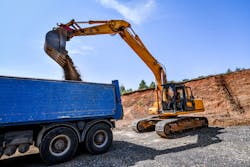Three steps to guarantee grease enhances equipment performance
In the world of construction, lubricants are critical to ensuring the smooth operation of heavy equipment, avoiding equipment breakdowns, and minimizing downtime of the project. As technological advancements bring newer, more efficient machinery to market, the greases and lubricants these machines rely on must also advance.
Content contributed by Zach Sutton, industrial, grease, coolants sector manager, Chevron.
Simultaneously, new market forces are changing lubricant manufacturers’ ability to reliably deliver products to customers when they need them. Of all the lithium mined in 2022, for example, 80% of it was used for batteries, and only 4% was used for lubricants and greases according to Statista.
Lubricant manufacturers must adapt to this market volatility to ensure products remain available now and into the future by reducing dependency on lithium-based greases. Grease manufacturers are also turning to new chemical compounds to provide reliability for customers who need greases for their equipment to function properly.
Although unforeseen issues are a norm in construction, proper lubrication is one of the fundamental aspects that directly impacts equipment performance and longevity.
Read also: How to keep preventive maintenance systems efficient
Equipment maintenance and lubrication can fall off the priority list. The cost of neglecting these items can be great when a machine breaks down and grinds the project to a halt. To avoid such a scenario, let’s explore the importance of equipment management and considerations for ensuring construction equipment is properly lubricated and functioning at peak performance.
Grease and machine compatibility
An area often overlooked that can cause unexpected interruptions is not paying attention to grease and machine compatibility. Fleet managers should ensure that the lubricant they add to a machine meets the machine’s OEM specifications for temperature and viscosity. But keep in mind, virtually every scenario for adding lubrication to a machine has unique considerations that can change the outcome. Factors like the base oil, additive chemistry, and the age and condition of the product can affect how the lubricant works with the machine. Fully purging a machine with a new grease and making sure it meets OEM specifications are two of the most important considerations when lubricating a piece of equipment.
Read also: Don’t slip up on grease use
Environmental considerations
Another thing to consider when applying lubricants to construction equipment is that a grease’s effectiveness is susceptible to change based on the temperature of the environment in which it is operating. Both the exterior temperature and the temperature within a component can affect the thickness and overall performance of a grease. Some lubricants are better suited for extremely cold or hot operating and environmental temperatures, so consider where and how that machine will be used to ensure the grease has the appropriate viscosity for its conditions.
The grease’s cleanliness is another factor that ultimately determines performance. When applying or transferring a grease, tiny particles become caught within the grease, which can cause damage and ultimately wear down a component. Each time a grease is transferred or handled, the more likely it is that the grease will acquire these tiny particles. Managers should ensure that greases are handled cleanly when being applied to the component to reduce the potential to pump unnecessary contamination into a system. Additionally, greases and grease guns should be stored in clean, cool, and dry locations to prevent contamination and additional damage.
Price v. cost analysis
The cost of improperly maintaining or lubricating equipment can be far greater than the upfront expense of lubricating a machine. When put in the context of the cost that can occur when something goes wrong, lubricating equipment is actually a cost savings technique, not an expense.
The ROI from machinery lubrication doesn’t come as a check, but rather as higher performance and efficiency, reduced downtime, and longer equipment life. Research from Polaris Labs states that lubrication represents an investment rate up to 45:1, meaning that for each $1,000 spent on quality lubricants and lubrication practices, a yield of $45,000 of savings is possible—underscoring the value of paying for a grease upfront to avoid damaging components and machinery down the road.
There is also a general belief among equipment managers that the most expensive grease is inherently the best solution for their machine, which is not necessarily true. Greases have different price points for a variety of reasons, but in all cases the best lubricant is the one that best fits a machine’s specifications and needs. Evaluating a grease based on its merit to coat and protect a machine component—instead of based on its price—is the best way to ensure it will function effectively.
By prioritizing equipment maintenance and adhering to these guidelines and considerations, construction companies can enhance equipment performance and achieve cost efficiency. Remember that the upfront cost of a lubricant is far less than the cost of replacing a component or machine in the event of a breakdown and is the No. 1 thing construction managers can do to prolong the lifespan of their equipment.
